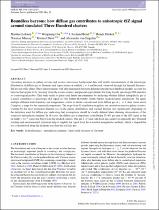| dc.contributor.author | Davé, Romeel | |
| dc.contributor.author | Lokken, Martine | |
| dc.contributor.author | Cui, Weiguang | |
| dc.date.accessioned | 2024-01-25T13:54:21Z | |
| dc.date.available | 2024-01-25T13:54:21Z | |
| dc.date.issued | 2023 | |
| dc.identifier.citation | Lokken, M., Cui, W., Bond, J.R., Hložek, R., Murray, N., Davé, R. and van Engelen, A., 2023. Boundless baryons: how diffuse gas contributes to anisotropic tSZ signal around simulated Three Hundred clusters. Monthly Notices of the Royal Astronomical Society, 523(1), pp.1346-1363. | en_US |
| dc.identifier.issn | 00358711 | |
| dc.identifier.uri | http://hdl.handle.net/10566/9267 | |
| dc.description.abstract | Upcoming advances in galaxy surveys and cosmic microwave background data will enable measurements of the anisotropic distribution of diffuse gas in filaments and superclusters at redshift z = 1 and beyond, observed through the thermal Sunyaev–Zel’dovich (tSZ) effect. These measurements will help distinguish between different astrophysical feedback models, account for baryons that appear to be ‘missing’ from the cosmic census, and present opportunities for using locally anisotropic tSZ statistics as cosmological probes. This study seeks to guide such future measurements by analysing whether diffuse intergalactic gas is a major contributor to anisotropic tSZ signal in THE THREE HUNDRED GIZMO-SIMBA hydrodynamic simulations. We apply multiple different halo boundary and temperature criteria to divide concentrated from diffuse gas at z = 1, then create mock Compton- y maps for the separated components. The maps from 98 simulation snapshots are centred on massive galaxy clusters, oriented by the most prominent filament axis in the galaxy distribution, and stacked. Results vary significantly depending on the definition used for diffuse gas, indicating that assumptions should be clearly defined when claiming observations of the warm-hot intergalactic medium. In all cases, the diffuse gas is important, contributing 25–60 per cent of the tSZ signal in the far field (>4 h−1 comoving Mpc) from the stacked clusters. The gas 1–2 virial radii from halo centres is especially key. Oriented stacking and environmental selections help to amplify the signal from the warm-hot intergalactic medium, which is aligned but less concentrated along the filament axis than the hot halo gas. | en_US |
| dc.language.iso | en | en_US |
| dc.publisher | Oxford University Press | en_US |
| dc.subject | Hydrodynamics | en_US |
| dc.subject | Intergalactic medium | en_US |
| dc.subject | Large-scale structure of Universe | en_US |
| dc.subject | Anisotropic tSZ signal | en_US |
| dc.subject | Boundless baryons | en_US |
| dc.title | Boundless baryons: how diffuse gas contributes to anisotropic tSZ signal around simulated three hundred clusters | en_US |
| dc.type | Article | en_US |

